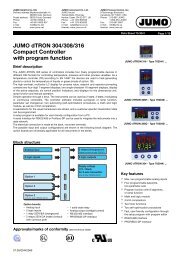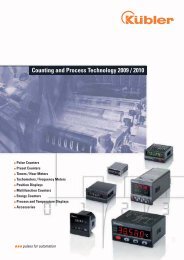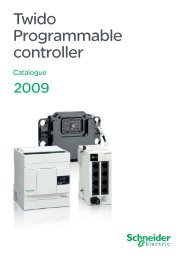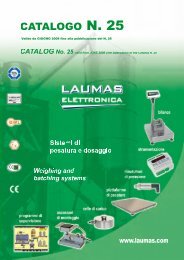Automation platform Modicon Premium
Automation platform Modicon Premium
Automation platform Modicon Premium
You also want an ePaper? Increase the reach of your titles
YUMPU automatically turns print PDFs into web optimized ePapers that Google loves.
Memory structure (continued)<br />
<strong>Modicon</strong> <strong>Premium</strong><br />
automation <strong>platform</strong><br />
Unity processors<br />
Processor with mixed type memory card in slot no. 0 and data<br />
storage type memory card in slot no. 1 (1)<br />
Internal RAM<br />
PCMCIA card<br />
(slot no. 0)<br />
96 to 2048 Ko<br />
128 to 7168 Ko<br />
Located data<br />
Global and DFB<br />
unlocated data<br />
Program and<br />
symbols<br />
Constants<br />
1<br />
1<br />
2<br />
3<br />
Memory structure (continued)<br />
Extension of the data storage area<br />
Memory cards reserved for data storage (4096 or 8192 Kb) are used to:<br />
b Access the data storage area in cases where the application is fully loaded into the<br />
internal RAM. In this case, the data storage memory card is inserted into PCMCIA<br />
slot no. 0.<br />
b Free up memory to serve as additional program space when the application is on<br />
the PCMCIA card (slot no. 0). In this case, the data storage memory card is inserted<br />
into PCMCIA slot no. 1 (although the memory card in slot no. 0 can still be used for<br />
some of the data).<br />
Unity Pro programming software helps the application designer to manage the<br />
structure and organize how the memory space on the <strong>Premium</strong> PLC is occupied.<br />
1<br />
2<br />
PCMCIA data<br />
storage card<br />
(slot no. 1)<br />
4096 or 8192 Ko<br />
(1) TSX P57 20 processors and higher<br />
Additional data<br />
storage (zone A)<br />
Additional data<br />
storage (zone B)<br />
4<br />
4<br />
Protecting the application<br />
Regardless of the PLC memory structure (whether the application is located in the<br />
internal RAM or on the PCMCIA card), it is possible to prevent the application from<br />
being accessed (for the purpose of reading or modifying the program) by only<br />
loading the executable code into the PLC.<br />
A memory protection bit, set in configuration mode, is also available to prevent any<br />
program modification (via the programming terminal or downloads).<br />
Program modification in online mode<br />
This function is different from previous versions of <strong>Premium</strong> PLCs (with PL7 software)<br />
in that it now allows program code and data from different parts of the application to<br />
be added or modified in a single modification session (thus making modification<br />
unified and consistent with regard to the controlled process).<br />
This increased flexibility comes at a cost in terms of the amount of program memory<br />
required. In order for the program to be modified in online mode, the amount of<br />
program memory space available must be at least equal to the combined size of all<br />
sections of the Unity Pro program affected by the single modification session<br />
concerned.<br />
3<br />
4<br />
5<br />
Depending on circumstances:<br />
b In the case of a processor with a memory extension card, there will be sufficient<br />
memory left on the card for online modification, provided that the recommendations<br />
on page 1/22 are observed.<br />
b In the case of a processor without a memory extension card, if the user wants to<br />
be able to make modifications in online mode, he or she must select a processor on<br />
the basis of the following:<br />
v The anticipated size of the application<br />
v The number and size of the program sections to be modified in online mode<br />
6<br />
7<br />
Note: A memory extension card based exclusively on Flash EPROM technology (without<br />
additional SRAM) is clearly incapable of supporting online program modifications.<br />
8<br />
9<br />
10<br />
Presentation:<br />
page 1/4<br />
Description:<br />
pages 1/5 …<br />
Characteristics:<br />
pages 1/10 …<br />
References:<br />
pages 1/12 …<br />
PCMCIA references:<br />
pages 1/22 …<br />
1/9







